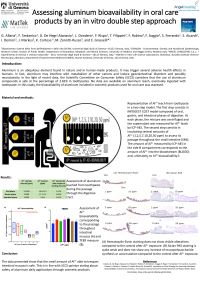Abstract
Introduction: Aluminum is an ubiquitous element found in nature and in human-made products. It may trigger several adverse health effects in humans. In fact, aluminum may interfere with metabolism of other cations and induce gastrointestinal disorders and possibly neurotoxicity. In the light of recent data, the Scientific Committee on Consumer Safety (SCCS) considers that the use of aluminum compounds is safe at the percentage of 2.65% in toothpastes. No data are available on aluminum leach, eventually ingested with toothpaste. In this study, the bioavailability of aluminum included in cosmetic products used for oral care was assessed.
Methods: To assess the effect of the aluminum in the case of accidental ingestion, toothpastes were subjected to in vitro digestion according to INFOGEST model. Oral phase was simulated by incubating toothpaste with simulated salivary fluid for 2 min at 37°C and pH 7.0 under agitation. The oral bolus was mixed with simulated gastric fluid for 2 h at 37°C and pH 3.0 under agitation. As last step, the gastric digesta was diluted with simulated intestinal fluid, for 2 h at 37°C and pH 7.0 under agitation. At the end of each phase, the mixture was centrifuged to separate the insoluble Al(OH)3 from Al3+ leached into the simulated fluid and stored for ICP-AES analyses. The bioavailability of accidentally ingested Al3+ was evaluated by incubating Al3+solutions with EpiIntestinal 3D model (MatTek). The tissues were incubated for 2 h using AlCl3 at different concentrations: 1, 2, 5, 7, 10, 20, 50 ppm. At the end of the experiment, the EpiIntestinal tissue barrier integrity was analyzed measuring transepithelial electric resistance (TEER). Moreover, tissue architecture was analyzed by light and electron microscopy. Margin of safety (MoS) was also calculated.
Results: Assessment by ICP-AES of Al3+ leached in the digestive phases detected high amount of Al3+ leached in salivary simulated fluid (167 ± 22.3 ppm). In the gastric phase Al3+ release was 17.7 ppm, corresponding to 0.05%. Finally, the amount released in the intestine was 0.14%, corresponding to 3 ppm. The Al3+ bioavailability was below the detection limit set at 0.02 ppm after the EpiIntestinal model’s incubation with different concentration of Al3+. TEER measures didn’t underline any differences for all the treatments with respect to negative control, thus showing absence of toxicity for all the Al3+ concentrations tested. These results were confirmed by histological evaluation of tissues. Moreover, MoS assessed for this experiment was more than 100.
Conclusions: The data presented show that the small amount of Al3+ able to trespass intestinal mucosa is safe. This is in line with SCCS opinion stating about safety of aluminum daily applications through cosmetic products.

